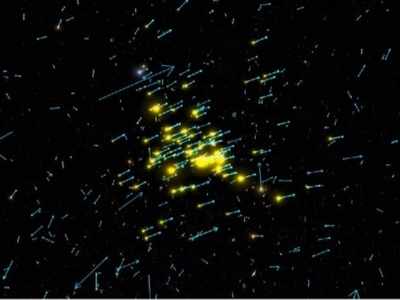
An example of the star cluster Hyades (in Rohini nakshatra). The arrows indicate the movement of the stars. The most likely cluster members are shown in yellow, all moving to the right with approximately 25 km/s. All stars in front or behind this group and having different velocities do not belong to the cluster. (Image credit: IIA/DST )
BENGALURU: Astronomers from the Indian Institute of Astrophysics (IIA) have developed a method based on Machine Learning (ML) that can identify cluster stars — assembly of stars physically related through common origin — with much greater certainty.
The method, which can be used on clusters of all ages, distances, and densities, has been used to identify hundreds of additional stars for six different clusters up to 18,000 light-years away and uncover peculiar stars. Their work has already resulted in discovering hot subdwarf-B type stars — compact stars that are very rare — in open cluster King 2.
A team of astronomers from IIA, an an autonomous institute of the department of science and technology (DST) in Bengaluru, used European Space Agency’s Gaia Early Data Release-3 which gives accurate information about brightness, parallax (effect whereby the position or direction of an object appears to differ when viewed from different positions), and proper motion of more than a billion stars to pick out stars that are cluster members.
The IIA team identified crucial measurements for this task and understood the complex relationship between these parameters, using an ML technique called Probabilistic Random Forest.
The method uses a combination of parallax, proper motion, temperature, brightness and other parameters to classify each star as a cluster member or not. The algorithm was trained using the most likely members from a model called the Gaussian Mixture Model, which can identify clumps of co-moving stars.
“The Probabilistic Random Forest algorithm then learned to identify a typical cluster member star and efficiently takes out stars that share only similar proper motions or only similar velocities as the cluster itself. Astronomers used 10 parameters to identify members, after performing a trade study of all available parameters in the catalogue,” the DST said.
The IIA team used the catalogue of members to identify the hottest stars in the six clusters using ultraviolet images from AstroSat, the Indian space observatory. This work has been published in the scientific journal ‘Monthly Notices of the Royal Astronomical Society’.
A research paper on King 2 discovery has been accepted for publication in the ‘Journal of Astrophysics and Astronomy’. The tool helped confirm that these stars are part of the cluster, though showing unexpected properties.
“Manual identification of stars belonging to a cluster is a daunting task owing to an armload of data to be analyzed. The new Artificial Intelligence based algorithm is very promising in automating and greatly speeding this process and may also find uses in other areas of analysis of patterns in biology and materials science,” DST secretary Prof Ashutosh Sharma said.
FacebookTwitterLinkedinEMail


